Cellular Breadboard
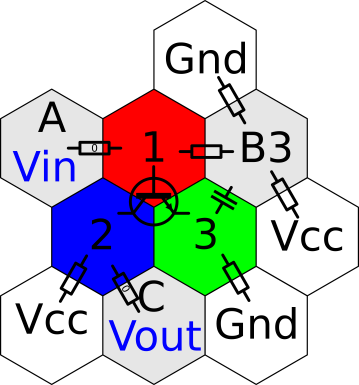
Once again, thinking about prototyping electronics, the author also wondered what topology of the prototype board would be optimal (in the sense of being the most flexible) for working with small SMD components, in particular, in cases like SOT23-3.
There are many options, but mostly they have “legs” from the original Veroboard topology - a board with a two-dimensional array of holes in 0.1-inch increments, with horizontal conductors that can be cut where required. There are also options with contact pads, not connected to each other, not connected to each other in pairs, and even without any printed conductors at all.
')
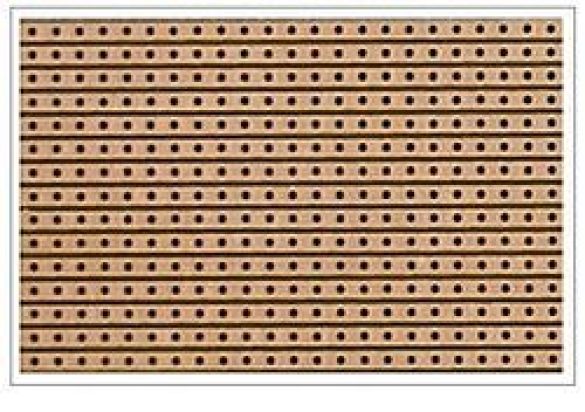
Veroboard board. Source: Wikipedia
The rights to the name Veroboard have been transferred from one company to another many times before returning to the English company Vero Technologies, the author lives next to. Somehow he might even go there. Also known as perfboard, stripboard.
Next, there are breadboard-type boards that do not require soldering, which makes it possible to repeatedly rework the circuit and change components without damaging them. But such boards, unlike previous ones, are unsuitable for working with SMD components, unless they are soldered to the feet. Such cards include, for example, Adafruit Perma-Proto.

Fee Adafruit Perma-Proto. Source: Adafruit website
The next option is to place as many different types of contact pads as possible on one universal board in order to fit as many kinds of components as possible. As, for example, made in the Universal Prototyping Board from Mike's Electric Stuff.
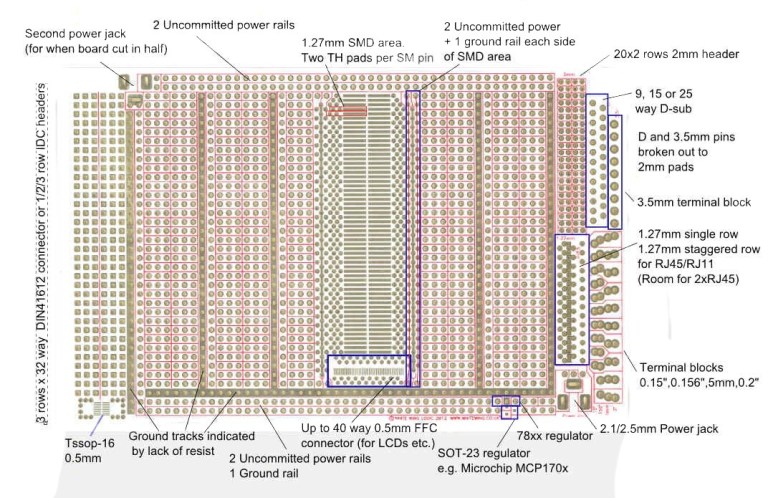
Universal Prototyping Board by White Wing Design. Source: whitewing.co.uk
This, of course, with a very big desire, can be done
If we aim to fill two-dimensional space with identical geometric figures without gaps (in fact, small gaps will still be needed to isolate the sites from each other), the role of these figures will fit, in particular, triangles, rectangles and hexagons, this task is called tiling. If the pads are triangular, pins of up to three components can be soldered to each of them:

If rectangular - up to four:

Well, if hexagonal - up to six, respectively:
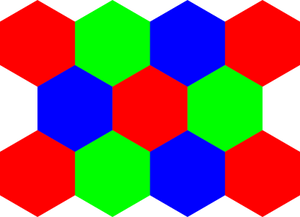
By combining these figures, you can get a “mock-up” that is interesting from the point of view of art rather than practice:

"Cellular" board is interesting to make so that the scheme can be assembled regardless of the order of the findings in the three-pin component. Sites marked with red (1), green (2) and blue (3) colors go to the component soldering point at the bottom of the SOT23-3 housing, platforms marked with letters A, B, C with numbers, as well as with Vcc and Gnd, connect the board with external circuits through small additional platforms, to which you can solder the comb. Since all the similar sites (A, B, C, Vcc, GND) are interconnected, the comb has only five pins. Sites marked in white are originally designed to provide power, but their role can be reassigned. Please also note that the sites marked in gray each have two alphanumeric designations: one at the top and the other at the bottom.
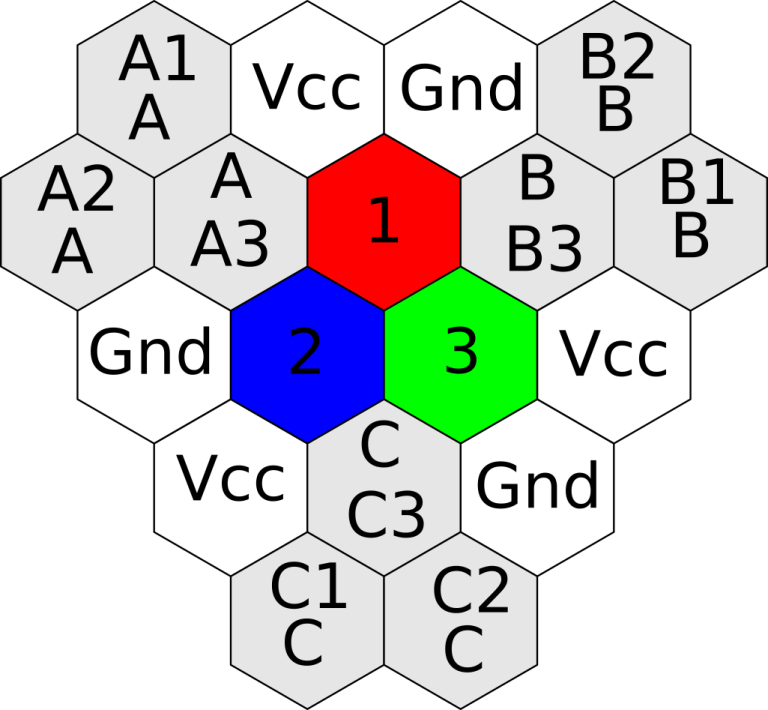
As the "bridges" between any two adjacent sites, you can use dual SMD components in housings 0603. These can be resistors, ceramic capacitors, diodes, even small inductors, etc. There are also jumpers in such housings, but they are easier to make from pieces of hard tinned wire.
There are a lot of variants of schemes that can be assembled on such a board. For example, an emitter follower:
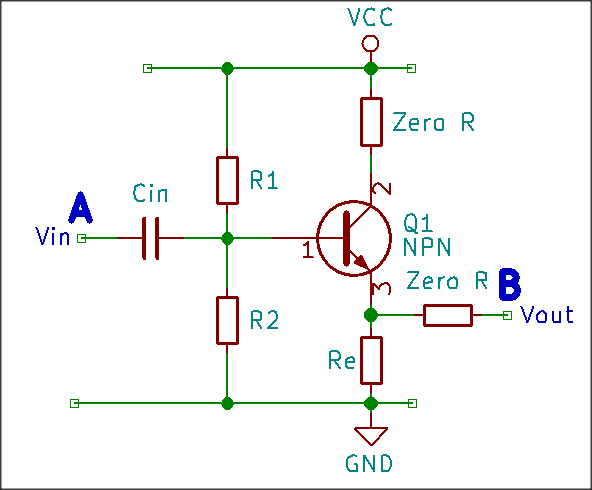
Turns into:
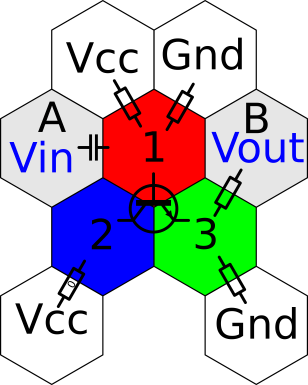
Supplement Cascade:

He is on the board:

Parametric stabilizer:

On the board, the comb pins are used outside the box: A - input, Vcc - output:

Phase shifting generator:

On the board, again non-standard use of sites: A - power, Vcc - output:

The author designed the following drawing of the board:

And he imagined how he would look if he was stuffed with components to the eye:

The required files in the KiCAD format are here under GPL v3.
And the boards came from China for $ 2 for 10 pieces:
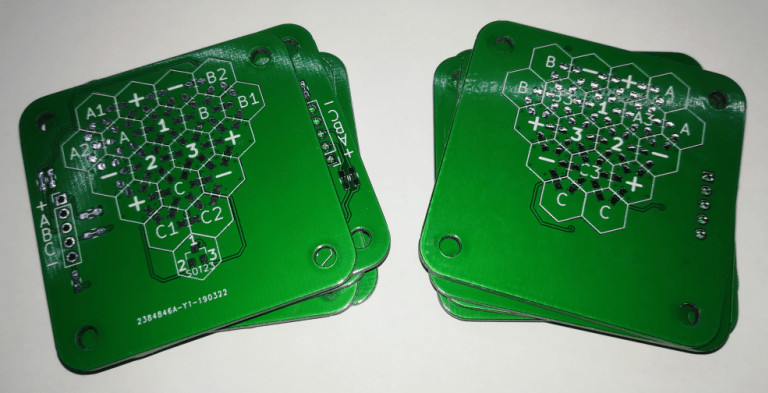
From the translator: it would be better to make “honeycombs” of a much smaller size, fill the entire space of the board with them, never connect them together, do not close anything with silk-screen printing, on the comb and special. a place for SOT23-3 does not display anything and generally does not provide for them. SOT23-3 can be soldered directly to any three sites, something like this:

It is clear that in this case it is necessary to place on the board not only components, but also jumpers of arbitrary shape, as on ordinary development boards. The advantage of being able to solder to one site up to six SMD components, while preserving.
Source: https://habr.com/ru/post/447088/
All Articles